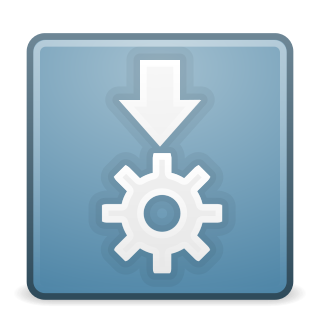Related Research Articles

In engineering and its various subdisciplines, acceptance testing is a test conducted to determine if the requirements of a specification or contract are met. It may involve chemical tests, physical tests, or performance tests.

A Linux distribution is an operating system made from a software collection that includes the Linux kernel, and often a package management system. Linux users usually obtain their operating system by downloading one of the Linux distributions, which are available for a wide variety of systems ranging from embedded devices and personal computers to powerful supercomputers.
Software testing is the act of examining the artifacts and the behavior of the software under test by validation and verification. Software testing can also provide an objective, independent view of the software to allow the business to appreciate and understand the risks of software implementation. Test techniques include, but are not necessarily limited to:
In computing, DLL Hell is a term for the complications that arise when one works with dynamic-link libraries (DLLs) used with Microsoft Windows operating systems, particularly legacy 16-bit editions, which all run in a single memory space.
In computing, cross-platform software is computer software that is designed to work in several computing platforms. Some cross-platform software requires a separate build for each platform, but some can be directly run on any platform without special preparation, being written in an interpreted language or compiled to portable bytecode for which the interpreters or run-time packages are common or standard components of all supported platforms.

The Linux Standard Base (LSB) was a joint project by several Linux distributions under the organizational structure of the Linux Foundation to standardize the software system structure, including the Filesystem Hierarchy Standard. LSB was based on the POSIX specification, the Single UNIX Specification (SUS), and several other open standards, but extended them in certain areas.
Dependency hell is a colloquial term for the frustration of some software users who have installed software packages which have dependencies on specific versions of other software packages.

ISO/IEC 9126Software engineering — Product quality was an international standard for the evaluation of software quality. It has been replaced by ISO/IEC 25010:2011.

AppImage is a format for distributing portable software on Linux without needing superuser permissions to install the application. It tries also to allow Linux distribution-agnostic binary software deployment for application developers, also called upstream packaging. Released first in 2004 under the name klik, it was continuously developed, then renamed in 2011 to PortableLinuxApps and later in 2013 to AppImage.
In systems engineering and requirements engineering, a non-functional requirement (NFR) is a requirement that specifies criteria that can be used to judge the operation of a system, rather than specific behaviours. They are contrasted with functional requirements that define specific behavior or functions. The plan for implementing functional requirements is detailed in the system design. The plan for implementing non-functional requirements is detailed in the system architecture, because they are usually architecturally significant requirements.
Application virtualization is a software technology that encapsulates computer programs from the underlying operating system on which they are executed. A fully virtualized application is not installed in the traditional sense, although it is still executed as if it were. The application behaves at runtime like it is directly interfacing with the original operating system and all the resources managed by it, but can be isolated or sandboxed to varying degrees.
Compatibility testing is a part of non-functional testing conducted on application software to ensure the application's compatibility with different computing environment.
Turbo is a set of software products and services developed by the Code Systems Corporation for application virtualization, portable application creation, and digital distribution. Code Systems Corporation is an American corporation headquartered in Seattle, Washington, and is best known for its Turbo products that include Browser Sandbox, Turbo Studio, TurboServer, and Turbo.

Salix OS is a multi-purpose Linux distribution based on Slackware.

Operational acceptance testing (OAT) is used to conduct operational readiness (pre-release) of a product, service, or system as part of a quality management system. OAT is a common type of non-functional software testing, used mainly in software development and software maintenance projects. This type of testing focuses on the operational readiness of the system to be supported, and/or to become part of the production environment. Hence, it is also known as operational readiness testing (ORT) or operations readiness and assurance testing (OR&A). Functional testing within OAT is limited to those tests which are required to verify the non-functional aspects of the system.

Chakra was a Linux distribution originally based on Arch Linux and focused on KDE software, intending to provide a KDE/Qt minimizing use of other widget toolkits where possible. It was well received by critics during its existence.

KDE Frameworks is a collection of libraries and software frameworks readily available to any Qt-based software stacks or applications on multiple operating systems. Featuring frequently needed functionality solutions like hardware integration, file format support, additional graphical control elements, plotting functions, and spell checking, the collection serves as technological foundation for KDE Plasma 5 and KDE Gear distributed under the GNU Lesser General Public License (LGPL).
ISO/IEC/IEEE 29119Software and systems engineering -- Software testing is a series of five international standards for software testing. First developed in 2007 and released in 2013, the standard "defines vocabulary, processes, documentation, techniques, and a process assessment model for testing that can be used within any software development lifecycle."
This article discusses a set of tactics useful in software testing. It is intended as a comprehensive list of tactical approaches to Software Quality Assurance (more widely colloquially known as Quality Assurance and general application of the test method.
References
- 1 2 "ISO/IEC/IEEE 29119-4 Software and Systems Engineering - Software Testing -Part 4- Test Techniques".
- ↑ "Portability Testing". OPEN Process Framework Repository Organization. Retrieved 29 April 2014.
- ↑ Rouse, Margaret. "DEFINITION environment" . Retrieved 29 April 2014.
- ↑ Mooney, James. "Bringing Portability to the Software Process" (PDF). Archived from the original (PDF) on 25 July 2008. Retrieved 29 April 2014.
- 1 2 3 4 5 6 7 8 Hass, Anne Mette Jonassen (2008). Guide to advanced software testing ([Online-Ausg.] ed.). Boston: Artech House. pp. 271–272. ISBN 978-1596932852.
- ↑ Salonen, Ville. "Automatic Portability Testing" (PDF). Retrieved 29 April 2014.
- 1 2 3 4 Salonen, Ville (October 17, 2012). "Automatic Portability Testing" (PDF). Ville Salonen. pp. 11–18. Retrieved 15 May 2014.
- 1 2 Woods, Anthony (2015). "Operational Acceptance - an application of the ISO 29119 Software Testing standard".
{{cite journal}}: Cite journal requires|journal=(help) - 1 2 3 4 "ISTQB Advanced Level Syllabi". ASTQB. Retrieved 29 April 2014.
- ↑ Hass, Anne Mette Jonassen (2008). Guide to advanced software testing ([Online-Ausg.] ed.). Boston: Artech House. pp. 272–273. ISBN 978-1596932852.
- ↑ "What is Compatibility testing in Software testing?". Mindstream Theme on Genesis Framework. Retrieved 29 April 2014.
- ↑ Hass, Anne Mette Jonassen (2008). Guide to advanced software testing ([Online-Ausg.] ed.). Boston: Artech House. p. 272. ISBN 978-1596932852.
- ↑ "Installability Guidelines" . Retrieved 29 April 2014.
- ↑ "What is Portability testing in software?". Mindstream Theme. Retrieved 29 April 2014.
- ↑ "Replaceability" . Retrieved 29 April 2014.
- ↑ Hass, Anne Mette Jonassen (2008). Guide to advanced software testing ([Online-Ausg.] ed.). Boston: Artech House. p. 273. ISBN 978-1596932852.